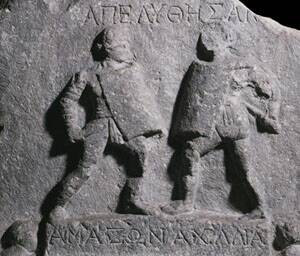
by fljustice | Aug 18, 2015 | Blog tour, Books, Essays/Research, Gladiators, Gladiatrix, History
Women Gladiators? Really?
 Yes, really! Whenever I pitched Sword of the Gladiatrix as my “lesbian gladiator novel,” I encountered raised eyebrows and skeptical snorts. The first question everyone asked: “Were there really lesbian gladiators?” My answer: “Of course!” We know there were female gladiators fighting in arenas for several centuries. Some had to be lesbian or tribades as the Romans would call them.
Yes, really! Whenever I pitched Sword of the Gladiatrix as my “lesbian gladiator novel,” I encountered raised eyebrows and skeptical snorts. The first question everyone asked: “Were there really lesbian gladiators?” My answer: “Of course!” We know there were female gladiators fighting in arenas for several centuries. Some had to be lesbian or tribades as the Romans would call them.
What really surprised people was the fact of female gladiators. They rarely appear in popular culture. Despite the popularity of Xena Warrior Princess and the myths of the Amazons, female gladiators don’t come to mind in the media-soaked imaginings of brutal, bloody, gladiatorial games. Women warriors? Maybe. Women gladiators? No. Yet they are there in grave markers, classical literature, laws, and art. All you have to do is look. (more…)
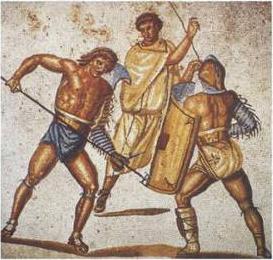
by fljustice | Jun 24, 2015 | Essays/Research, Gladiators, Gladiatrix, History
Food in the First Century Roman Empire
 Prism Book Alliance pitched me the guest post topic: “If your character could only eat ten foods for the rest of her life, what would they be and why?” I was initially stumped then delighted. Historical fiction writers are notorious for their collections of arcana regarding food, clothing, religious practices, architecture, social mores, herb lore, etc. Using such details in our narratives is one of the ways we transport our readers to another time and place. My novel, Sword of the Gladiatrix, takes place in the first century and features two women from the far ends of the Roman Empire: Afra, a huntress from the Kingdom of Kush, and Cinnia, a warrior-bard of the rebellious Iceni tribe in Roman Britain. Both have very different cultures and diets compared to the Romans who enslave them, so let’s time travel! (more…)
Prism Book Alliance pitched me the guest post topic: “If your character could only eat ten foods for the rest of her life, what would they be and why?” I was initially stumped then delighted. Historical fiction writers are notorious for their collections of arcana regarding food, clothing, religious practices, architecture, social mores, herb lore, etc. Using such details in our narratives is one of the ways we transport our readers to another time and place. My novel, Sword of the Gladiatrix, takes place in the first century and features two women from the far ends of the Roman Empire: Afra, a huntress from the Kingdom of Kush, and Cinnia, a warrior-bard of the rebellious Iceni tribe in Roman Britain. Both have very different cultures and diets compared to the Romans who enslave them, so let’s time travel! (more…)

by fljustice | Jun 16, 2015 | Essays/Research, Gladiators, Gladiatrix, History
How I Die a Dozen Deaths
“How do you think you would do in a battle arena?”
 When I got this suggested topic, I thought to myself, “Great! Shortest blog post ever—I die!” Then I thought about it and realized there are a few—very few—situations where I might survive. After all I have my protagonist in Sword of the Gladiatrix survive a beast hunt with broken ribs and sprained ankle (more on that later). First some stipulations:
When I got this suggested topic, I thought to myself, “Great! Shortest blog post ever—I die!” Then I thought about it and realized there are a few—very few—situations where I might survive. After all I have my protagonist in Sword of the Gladiatrix survive a beast hunt with broken ribs and sprained ankle (more on that later). First some stipulations:
- “Me” is me in my prime when I could play multiple games of tennis, ride my bike for hours, and did weight training three times a week; not the aging, out-of-shape, couch potato I am now.
- I have training for whatever fighting style I’m engaging in.
- The fight would take place at a regional Roman arena (at Pompeii or Nuceria for example), not one of the imperial extravaganzas where the object is to kill as many people and animals as possible.
A little history:
Gladiator shows or munera evolved out of a Roman religious ritual where slaves were forced to fight to the death at a funeral to honor the dead. By the first century they became part of larger multi-day religious celebrations (political theater) usually sponsored by local magistrates and might include plays, music, chariot racing, and other entertainments. By AD 354 gladiator fights declined to just 10 days out of 176 set aside for spectacles of various kinds in Rome. (more…)

by fljustice | Apr 2, 2015 | Biographies, Books, History, Reviews, Wonderful Women
Boudica, Queen of the Iceni:
Two books
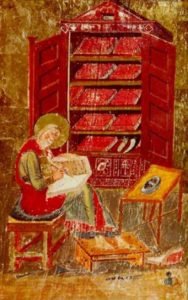 We authors—especially of historical fiction—cannot get along without our research books. (We also like to visit the places we write about, explore museum exhibits, and participate in archaeology and reenactments, but this post will talk about research of the armchair variety.) We prefer primary sources: journals, diaries, letters, histories, account lists, and literature written in the period, describing the people and events we want to write about; but that’s not always possible. For cultures that didn’t have a written language (the Iron Age Celts), or it was indecipherable (Egyptian hieroglyphs until the discovery of the Rosetta stone), or it was destroyed (Mayan books burned by conquering Spaniards); we have to rely on secondary sources. Books, essays, and articles by academics and other professionals in their fields are the best we can do for written research in such cases. But we have to be careful even with those. Just as in evaluating primary sources we have to keep in mind the biases and knowledge of the writer, we have to do the same with secondary sources. Let’s face it, there’s a lot of dreck out there—particularly on the internet—and historical fiction authors usually like to get as close to the truth as possible.
We authors—especially of historical fiction—cannot get along without our research books. (We also like to visit the places we write about, explore museum exhibits, and participate in archaeology and reenactments, but this post will talk about research of the armchair variety.) We prefer primary sources: journals, diaries, letters, histories, account lists, and literature written in the period, describing the people and events we want to write about; but that’s not always possible. For cultures that didn’t have a written language (the Iron Age Celts), or it was indecipherable (Egyptian hieroglyphs until the discovery of the Rosetta stone), or it was destroyed (Mayan books burned by conquering Spaniards); we have to rely on secondary sources. Books, essays, and articles by academics and other professionals in their fields are the best we can do for written research in such cases. But we have to be careful even with those. Just as in evaluating primary sources we have to keep in mind the biases and knowledge of the writer, we have to do the same with secondary sources. Let’s face it, there’s a lot of dreck out there—particularly on the internet—and historical fiction authors usually like to get as close to the truth as possible.
In researching Sword of the Gladiatix, I collected several books, articles, and pamphlets on Boudica and Roman Britain, most of an academic nature, a few of the more “popular” variety. The two biographies of Boudica I review below are the best by far of both types. You can read either or both and get a well-researched, readable history of the Iceni Queen, her times, and her legacy in popular culture. Which to read depends on your needs and nature. (more…)

by fljustice | Mar 11, 2015 | Essays/Research, History, Wonderful Women
Boudica, Warrior Queen
It’s Women’s History Month and I’ve exhausted my favorite topic of Hypatia, Lady Philosopher of Alexandria. Time to move on to another fascinating woman who has been extensively mythologized: Boudica, Queen of the Iceni (a British Celtic tribe) in the first century AD. For those of you unfamiliar with her story, here is a brief summary.
Some Background
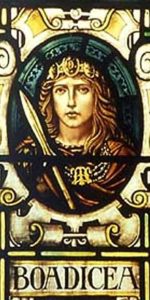
Image of Boudica in stained glass in Colchester Town Hall.
Julius Caesar invaded Britain in 55 BC and again in 56 where he had some military success against local tribes. He withdrew to Gaul and never returned to Britain. Roman influence in Britain grew over the next 80 years due to increased trade. The British tribes quarreled and Caratacus, the leader of the Catuvellauni expanded his tribe’s territory at the expense of the Atrebates. The Atrebates chief Verica appealed to Rome and gave the Emperor Claudius an excuse to invade Britain in AD 43. General Plautius led the assault and Claudius joined him with reinforcements. They took Caratacus’ stronghold Camulodunum (modern Colchester) and established the first Roman colonia—towns founded for Roman citizens—on British soil. Eleven tribal kings surrendered. Claudius declared Britain a Roman province.
Caractacus continued to fight, leading the western tribes in Wales in guerrilla actions against Plautius’ successor Scapula, known for his brutal pacification campaign in the south. Scapula finally defeated Caractacus in 51. Caractacus fled a to the Brigantes tribe (in modern-day Yorkshire) but was betrayed by their Queen Cartimandua and handed over to the Romans. In 59 and 60, the Roman governor Caius Suetonius Paulinus (during Nero’s reign) led the successful invasion and pacification of Wales and the Isle of Anglesey, the seat of the Druids. (more…)
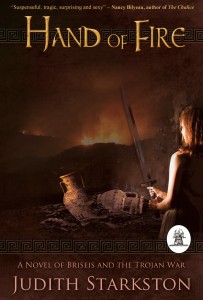
by fljustice | Sep 19, 2014 | Books, Fiction, Free stuff, Reviews, Wonderful Women
Book Review and Giveaway:
“Hand of Fire” by Judith Starkston
I get pitched a lot of books. I usually accept about one a month. I like most of them and write a paragraph or two on GoodReads.com, LibraryThing.com or Amazon.com. A very few get the full blog treatment. Hand of Fire by Judith Starkston is one of those I want to enthusiastically share with my fellow readers. Her novel has all the elements I look for in historical fiction: compelling characters, engaging plot, and fascinating setting.
About the book:
 The Trojan War threatens Troy’s allies and the Greek supply raids spread. A young healing priestess, designated as future queen, must defend her city against both divine anger and invading Greeks. She finds strength in visions of a handsome warrior god; will that be enough when the half-immortal Achilles attacks? Hand of Fire, a tale of resilience and hope, blends history and legend in the untold story of Achilles’s famous captive, Briseis.
The Trojan War threatens Troy’s allies and the Greek supply raids spread. A young healing priestess, designated as future queen, must defend her city against both divine anger and invading Greeks. She finds strength in visions of a handsome warrior god; will that be enough when the half-immortal Achilles attacks? Hand of Fire, a tale of resilience and hope, blends history and legend in the untold story of Achilles’s famous captive, Briseis.
My review:
I have a weakness for stories that shine a light on little known women or give silenced women a voice in the way Anita Diamant spoke for the biblical Dina (Joseph’s only sister) in her wildly popular The Red Tent. Starkston takes a similar approach through the story of Briseis. In the Iliad Briseis has only a handful of lines, yet she is a pivotal character in the narrative arc of the classic poem, sparking a rift between Achilles and Agamemnon that almost brings the Greek war against Troy to ruin. In the poem she expresses her love for Achilles in spite of the fact that he killed her brothers and husband, sacked her city, and reduced her status from princess to slave. A tall order to build a believable scenario where that could happen! Starkston does a beautiful job taking the slender clues about Briseis’ life and times and building believable characters. Briseis matures from an uncertain girl to a woman capable of determining her own destiny in this engaging story. (more…)

 Yes, really! Whenever I pitched Sword of the Gladiatrix as my “lesbian gladiator novel,” I encountered raised eyebrows and skeptical snorts. The first question everyone asked: “Were there really lesbian gladiators?” My answer: “Of course!” We know there were female gladiators fighting in arenas for several centuries. Some had to be lesbian or tribades as the Romans would call them.
Yes, really! Whenever I pitched Sword of the Gladiatrix as my “lesbian gladiator novel,” I encountered raised eyebrows and skeptical snorts. The first question everyone asked: “Were there really lesbian gladiators?” My answer: “Of course!” We know there were female gladiators fighting in arenas for several centuries. Some had to be lesbian or tribades as the Romans would call them.





